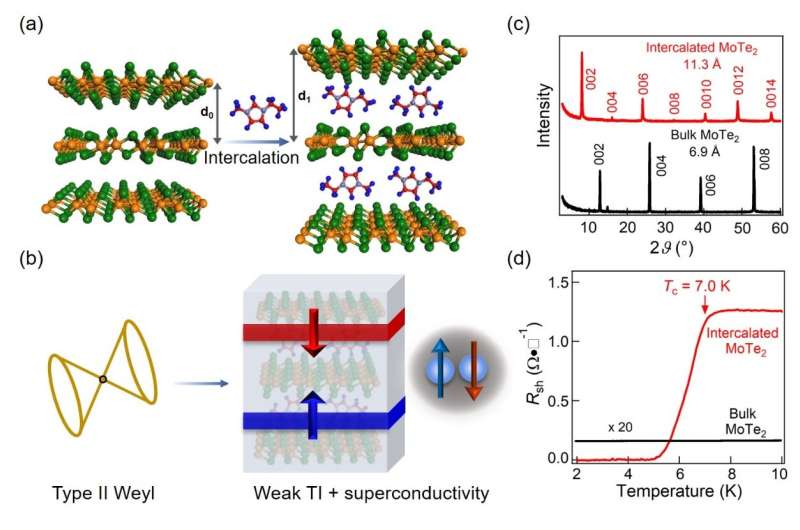Organic-cation intercalation: An effective strategy for manipulating band topology and superconductivity

In a recent article published in Science Bulletin, researchers developed an effective organic-cation intercalation strategy to manipulate the interlayer coupling of layered materials, and obtain a class of organic-inorganic hybrid crystals with tailored topological properties and enhanced superconductivities.
Reducing dimensionality is a direct pathway to manipulate interlayer coupling of layered materials for inducing exotic properties. For instance, WTe2, which is a non-superconducting Weyl semimetal in bulk, could host quantum spin Hall effect with superconducting transition temperature Tc ~ 0.82 K when the thickness is decreased to monolayer. However, reducing dimensionality requires complex growth or exfoliation and the monolayer samples are often unstable in ambient conditions. Developing an effective and facile method to manipulate interlayer coupling to achieve tailored properties is therefore highly desirable.
Recently, researchers led by Shuyun Zhou and Pu Yu from Tsinghua University co-developed an organic-cation intercalation strategy for layered materials. They start from Weyl semimetals MoTe2 and WTe2, and the intercalated samples exhibit tailored topological properties, enhanced superconductivities and good sample stabilities. The intercalated MoTe2 shows Tc of 7.0 K as compared to Tc of 0.25 K in its bulk counterpart, and is comparable to monolayer flake. More importantly, the intercalated WTe2 exhibits enhanced Tc of 2.3 K, which is 2.8 times of Tc ~ 0.82 K in the monolayer sample, suggesting that the intercalation method is very effective in boosting the superconductivity. Such manipulation of both band topology and superconductivity in intercalated MoTe2 and WTe2 provides a promising platform to realize topological superconductivity and Majorana zero-mode.
The impact of the intercalation methodology developed in this work on future engineering of other layered materials is also far-reaching. As highlighted by Xianfeng Duan from UCLA in the News & Views published in the same issue, "The molecular intercalation approach offers a versatile strategy to tailor the dimensionality and topological nature of the layered crystals, and defines an entirely new class of organic-inorganic superlattice structures for elaborately engineering the electronic states and complex band-structure topology to enable exotic properties and devices."

More information: Haoxiong Zhang et al, Enhancement of superconductivity in organic-inorganic hybrid topological materials, Science Bulletin (2019). DOI: 10.1016/j.scib.2019.11.021
Provided by Science China Press





















